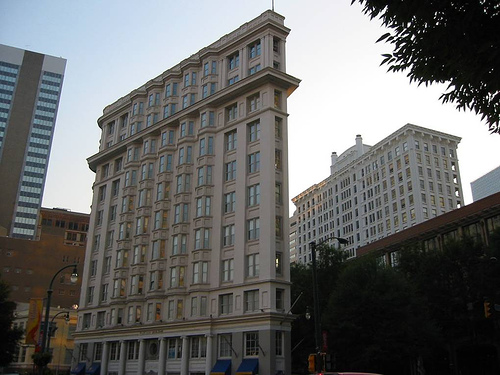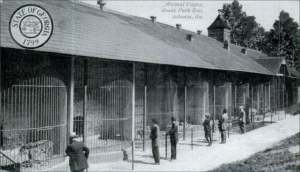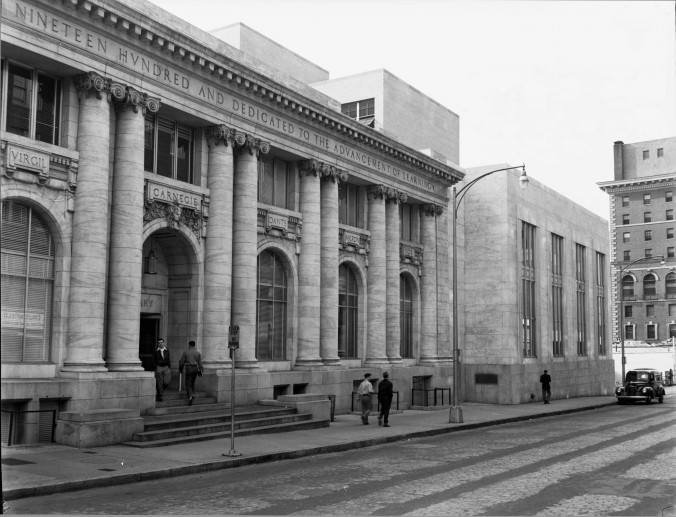Growing up thirty minutes outside of Atlanta has its perks. For me, the best thing about it was going to Braves games. By the age of 10, I considered myself a dedicated Atlanta Braves fan. I’d stay up late fantasizing about inviting Braves players to my birthday party or playing for the team in the big leagues. The main reason I live in Atlanta today is because those games made me fall in love with the city. Atlanta has so much life and energy so I’ve always been intrigued by its history. While Turner Field became the permanent home of the Braves following the 1996 Olympics, I never got the chance to witness a game in the Braves’ former ballpark, Atlanta-Fulton County Stadium. Yet, the remnants of the coliseum still stand tall and firm, casting a long shadow over the infamous Turner Field ‘blue lot’ reserved for commuting fans. My passion for the Braves and curiosity of Atlanta-Fulton County Stadium inspired me to identify the party responsible for bringing my favorite team to the city; that search led me to a familiar name, Ivan Allen, Jr. An individual whose impact on Atlanta stands tall and firm much like the memorial wall wrapping around the blue lot today.
the histories of our streets
Georgia State University students map Atlanta's past
Month: March 2016
Atlanta-Fulton County Stadium: Mayor Allen’s Impact on Atlanta
The Flatiron Building of Atlanta Georgia
Everyone who drives through Atlanta on interstate-85 will wind through the city passing by a multitude of skyscrapers. Coming south from the north, you will pass the iconic Olympic torch, the Varsity, the Bank of America plaza (the “Pencil building”), the W, and the Westin, among others. Atlanta is ever-growing as cranes are scattered throughout the city, adding more lines and structure to the skyline. But if you drive off the highway and head deeper into the city to find the Fairlie-Poplar Historic District, you can get a glimpse of the elders amongst the giants.
Zoo Atlanta has gone through different periods of being a top Zoo in the nation. From either being one of the first Zoos in the United States in 1889. To then being one of the first Zoos to have a gorilla. Then in the more recent period being one of four Zoos in the United States to have pandas. What happened between these different show casing is one of many rebuilding projects, as the Zoo has nearly fell apart during multiple different periods. This is the story behind those different phases.
Talking a walk down Auburn Avenue is an experience that many Atlanta residents and tourists have enjoyed. When walking down Auburn, it is easy to be taken aback by how beautiful the birth home of Dr. King is. It is easy for residents and tourist to stop and admire the burial site of Dr. King and his wife Coretta Scott King. Tourists and residents are blown away when they view the massive mural of civil rights leader and congressman John Lewis. With all of these civil rights giants in one small street it is easy to understand why the John Wesley Dobbs Plaza on the corner of Auburn and Fort Street does not get much attention. Hundreds of people drive or walk pass the plaza on a daily basis and yet one does not find many people stepping inside the plaza and admiring the statue of John Wesley Dobbs. The plaza is overshadowed by the presence of Dr. King’s historical site and John Lewis’ mural, which is an appropriate metaphor as to how the legacy of Mr. Dobbs has been largely forgotten by the mainstream public.
The history of Atlanta’s Carnegie Library is the story of a building, the story of the people who used its services and the story of the systems that were built to maintain and take advantage of it. Unknown to most Atlantans is that the public library system, seen as an everyday, normal part of life in Atlanta, had its very beginnings in that building. The story of this old building is particularly difficult to grasp because it has been torn down and replaced with the new Atlanta-Fulton Public Library on the same piece of land. In this report, I found it important to embrace the human element by discussing the works of individuals to create the Carnegie Library system, such as Anne Wallace and Andrew Carnegie. But I also did not wish to ignore the social and economic factors that affected it, such as the racial politics of the Jim Crow South. The connections between an international system of Carnegie libraries and the specific Atlanta branches helped to bring historical context and answer questions of continuity and perception.
Subscribe by Email
Completely spam free, opt out any time.
Please, insert a valid email.
Thank you, your email will be added to the mailing list once you click on the link in the confirmation email.
Spam protection has stopped this request. Please contact site owner for help.
This form is protected by reCAPTCHA and the Google Privacy Policy and Terms of Service apply.

Header image: George F. Cram, Atlanta (1883)
© 2024 the histories of our streets
Theme by Anders Noren — Up ↑



